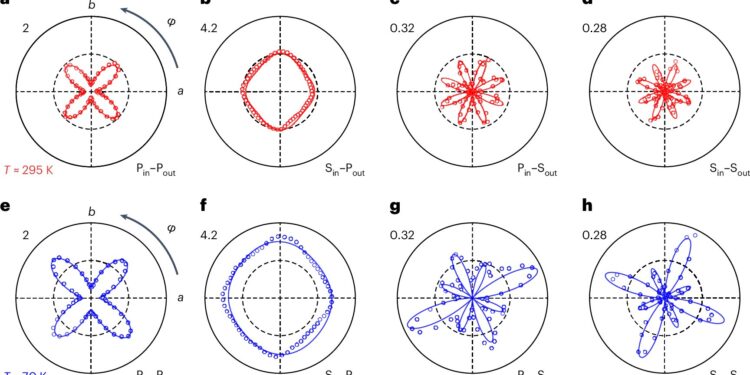Spontaneous breaking of mirror symmetry in Pb-Bi2212 (p ≈ 0.205). Credit: Physics of nature (2024). DOI: 10.1038/s41567-024-02601-1
Materials that exhibit superconducting properties at high temperatures, called high-temperature superconductors, have been the subject of much recent study because they can be used to develop new technologies that work well at higher temperatures. Although high-temperature superconductivity has been widely studied, its underlying physics is not yet fully understood.
A key step toward a better understanding of high-temperature superconductivity is to identify the ordered phases of high-temperature superconductors and their underlying symmetries. Indeed, phase transitions in these materials could be related to their superconductivity.
Researchers at Seoul National University in Korea recently conducted a study exploring the phases and associated symmetries in the material cuprate (Bi, Pb)2Mr.2CaCu2O8+δ. Their conclusions, published in Physics of naturerevealed a Fermi liquid-like phase present in this material beyond critical doping, characterized by broken mirror symmetry.
“About four years ago, we were looking for an experiment suitable for our new equipment called rotational anisotropy second harmonic generation (RA-SHG), which is a very sensitive technique and has become an important experimental tool,” Changyoung Kim, co-author of the paper, told Phys.org.
“There were some suggestions that there might be a new phase in a region of the copper oxide or cuprate superconductor phase diagram, called the overdoped region. Instinct took over and we realized that SHG was a suitable tool to search for such phases.”
The superconductivity of cuprate superconductors can be modulated using a technique known as doping, which involves adding impurities or other elements to a material to change its properties.
Orthorhombic crystallographic structure of Pb-Bi2212 with p > pc. Credit: Physics of nature (2024). DOI: 10.1038/s41567-024-02601-1
This process allows researchers to selectively obtain superconductors, metals or insulators. The amount of doping at which superconductivity can be achieved at the highest temperature is about 0.15, with anything higher than this being considered “overdoping”.
Recent studies have shown that overdoped cuprate superconductors may exhibit a new phase. Kim and his colleagues set out to probe this phase using lead-doped superconductors previously synthesized in their labs.
“Symmetries tell us a lot about nature,” Kim explains. “That’s why it’s important to understand them in physics research. However, symmetries can sometimes be subtle (or sometimes hidden) and so it can be very difficult to identify symmetries (or broken symmetries). SHG is a technique that allows us to detect symmetries or their breaking in the most sensitive way possible.”
Using the RA-SHG developed in their laboratory, the researchers performed a series of tests on (Bi,Pb)2Mr.2CaCu2O8+δ samples that have been doped beyond critical doping. Critical doping is a state in which the concentration of dopants introduced into a material exceeds a specific threshold, beyond which the material will exhibit different physical properties.
“In physics, there is something called a quantum phase transition, a phase transition that occurs at zero Kelvin (absolute zero temperature),” Kim explains. “The point at which the phase transition occurs at 0 K is called the quantum critical point. High-temperature superconductivity is thought to be related to this quantum critical point.”
“In the case of cuprate superconductors, the critical doping is about 0.19 and our experiments were performed on samples that exceeded this value.”
Phase diagram of superconducting copper oxides. Credit: Physics of nature (2024). DOI: 10.1038/s41567-024-02602-0
The researchers discovered a broken mirror symmetry in their cuprate sample, specifically in a Fermi liquid-like phase that occurs beyond critical doping. The temperature at which this phase was observed coincides with the temperature at which strange metals typically transform into Fermi liquid-like metals.
“The symmetries provide important information, and it is expected that this information can lead us to the microscopic mechanism of high-temperature superconductivity,” Kim said. “That is why identifying the phases and their symmetries has been the focus of research on cuprate superconductors.”
“In our work, we discovered a new phase and its symmetry in the phase diagram. The symmetry of the new phase can help us identify the phase, which in turn can give us more information about how an electron interacts with other electrons or its environment.”
The new phase discovered in this recent study could soon be examined in more detail using a variety of other experimental techniques. Kim and his colleagues hope that their recent and future studies will contribute to the understanding of high-temperature superconductivity.
“Although our work strongly suggests that there is a new phase, it is also important to verify with other experimental techniques,” Kim added. “Experiments with other techniques are ongoing. In particular, we hope to identify the new phase (SHG tells us the type of symmetries of the new phase but not what it is). We also plan to continue theoretical research in collaboration with a group of theorists.”
More information:
Saegyeol Jung et al, Spontaneous mirror symmetry breaking in cuprate beyond critical doping, Physics of nature (2024). DOI: 10.1038/s41567-024-02601-1
Alessandra Milloch et al, New order in the phase diagram of copper oxide, Physics of nature (2024). DOI: 10.1038/s41567-024-02602-0
© 2024 Science X Network
Quote: Study reveals broken mirror symmetry in Fermi liquid phase of cuprate (2024, August 27) retrieved August 28, 2024 from
This document is subject to copyright. Apart from any fair dealing for the purpose of private study or research, no part may be reproduced without written permission. The content is provided for informational purposes only.



